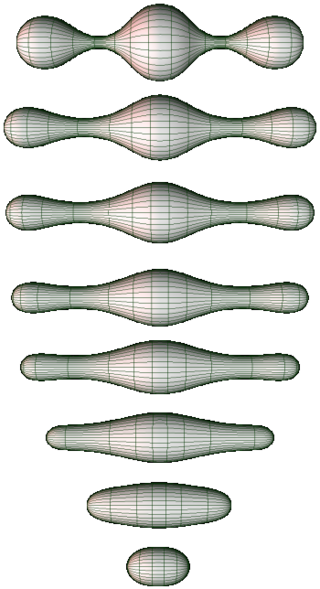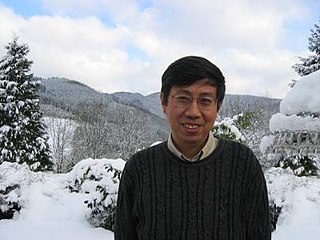Related Research Articles

In algebraic and differential geometry, a Calabi–Yau manifold, also known as a Calabi–Yau space, is a particular type of manifold which has certain properties, such as Ricci flatness, yielding applications in theoretical physics. Particularly in superstring theory, the extra dimensions of spacetime are sometimes conjectured to take the form of a 6-dimensional Calabi–Yau manifold, which led to the idea of mirror symmetry. Their name was coined by Candelas et al. (1985), after Eugenio Calabi, who first conjectured that such surfaces might exist, and Shing-Tung Yau, who proved the Calabi conjecture.
In differential geometry, the Ricci curvature tensor, named after Gregorio Ricci-Curbastro, is a geometric object which is determined by a choice of Riemannian or pseudo-Riemannian metric on a manifold. It can be considered, broadly, as a measure of the degree to which the geometry of a given metric tensor differs locally from that of ordinary Euclidean space or pseudo-Euclidean space.
In the mathematical field of Riemannian geometry, the scalar curvature is a measure of the curvature of a Riemannian manifold. To each point on a Riemannian manifold, it assigns a single real number determined by the geometry of the metric near that point. It is defined by a complicated explicit formula in terms of partial derivatives of the metric components, although it is also characterized by the volume of infinitesimally small geodesic balls. In the context of the differential geometry of surfaces, the scalar curvature is twice the Gaussian curvature, and completely characterizes the curvature of a surface. In higher dimensions, however, the scalar curvature only represents one particular part of the Riemann curvature tensor.

In the mathematical fields of differential geometry and geometric analysis, the Ricci flow, sometimes also referred to as Hamilton's Ricci flow, is a certain partial differential equation for a Riemannian metric. It is often said to be analogous to the diffusion of heat and the heat equation, due to formal similarities in the mathematical structure of the equation. However, it is nonlinear and exhibits many phenomena not present in the study of the heat equation.

Shing-Tung Yau is a Chinese-American mathematician. He is the director of the Yau Mathematical Sciences Center at Tsinghua University and professor emeritus at Harvard University. Until 2022, Yau was the William Caspar Graustein Professor of Mathematics at Harvard, at which point he moved to Tsinghua.
In mathematics and especially differential geometry, a Kähler manifold is a manifold with three mutually compatible structures: a complex structure, a Riemannian structure, and a symplectic structure. The concept was first studied by Jan Arnoldus Schouten and David van Dantzig in 1930, and then introduced by Erich Kähler in 1933. The terminology has been fixed by André Weil. Kähler geometry refers to the study of Kähler manifolds, their geometry and topology, as well as the study of structures and constructions that can be performed on Kähler manifolds, such as the existence of special connections like Hermitian Yang–Mills connections, or special metrics such as Kähler–Einstein metrics.

Eugenio Calabi was an Italian-born American mathematician and the Thomas A. Scott Professor of Mathematics at the University of Pennsylvania, specializing in differential geometry, partial differential equations and their applications.
In differential geometry and mathematical physics, an Einstein manifold is a Riemannian or pseudo-Riemannian differentiable manifold whose Ricci tensor is proportional to the metric. They are named after Albert Einstein because this condition is equivalent to saying that the metric is a solution of the vacuum Einstein field equations, although both the dimension and the signature of the metric can be arbitrary, thus not being restricted to Lorentzian manifolds. Einstein manifolds in four Euclidean dimensions are studied as gravitational instantons.
In differential geometry, a hyperkähler manifold is a Riemannian manifold endowed with three integrable almost complex structures that are Kähler with respect to the Riemannian metric and satisfy the quaternionic relations . In particular, it is a hypercomplex manifold. All hyperkähler manifolds are Ricci-flat and are thus Calabi–Yau manifolds.

Richard Streit Hamilton was an American mathematician who served as the Davies Professor of Mathematics at Columbia University.
In the mathematical field of differential geometry, there are various splitting theorems on when a pseudo-Riemannian manifold can be given as a metric product. The best-known is the Cheeger–Gromoll splitting theorem for Riemannian manifolds, although there has also been research into splitting of Lorentzian manifolds.
In differential geometry, a quaternion-Kähler manifold (or quaternionic Kähler manifold) is a Riemannian 4n-manifold whose Riemannian holonomy group is a subgroup of Sp(n)·Sp(1) for some . Here Sp(n) is the sub-group of consisting of those orthogonal transformations that arise by left-multiplication by some quaternionic matrix, while the group of unit-length quaternions instead acts on quaternionic -space by right scalar multiplication. The Lie group generated by combining these actions is then abstractly isomorphic to .
In the mathematical field of differential geometry, the Calabi conjecture was a conjecture about the existence of certain kinds of Riemannian metrics on certain complex manifolds, made by Eugenio Calabi. It was proved by Shing-Tung Yau, who received the Fields Medal and Oswald Veblen Prize in part for his proof. His work, principally an analysis of an elliptic partial differential equation known as the complex Monge–Ampère equation, was an influential early result in the field of geometric analysis.

Tian Gang is a Chinese mathematician. He is a professor of mathematics at Peking University and Higgins Professor Emeritus at Princeton University. He is known for contributions to the mathematical fields of Kähler geometry, Gromov-Witten theory, and geometric analysis.
In Riemannian geometry, a branch of mathematics, harmonic coordinates are a certain kind of coordinate chart on a smooth manifold, determined by a Riemannian metric on the manifold. They are useful in many problems of geometric analysis due to their regularity properties.
In differential geometry, a Kähler–Einstein metric on a complex manifold is a Riemannian metric that is both a Kähler metric and an Einstein metric. A manifold is said to be Kähler–Einstein if it admits a Kähler–Einstein metric. The most important special case of these are the Calabi–Yau manifolds, which are Kähler and Ricci-flat.
Huai-Dong Cao is a Chinese–American mathematician. He is the A. Everett Pitcher Professor of Mathematics at Lehigh University. He is known for his research contributions to the Ricci flow, a topic in the field of geometric analysis.

Thierry Aubin was a French mathematician who worked at the Centre de Mathématiques de Jussieu, and was a leading expert on Riemannian geometry and non-linear partial differential equations. His fundamental contributions to the theory of the Yamabe equation led, in conjunction with results of Trudinger and Schoen, to a proof of the Yamabe Conjecture: every compact Riemannian manifold can be conformally rescaled to produce a manifold of constant scalar curvature. Along with Yau, he also showed that Kähler manifolds with negative first Chern classes always admit Kähler–Einstein metrics, a result closely related to the Calabi conjecture. The latter result, established by Yau, provides the largest class of known examples of compact Einstein manifolds. Aubin was the first mathematician to propose the Cartan–Hadamard conjecture.
The Geometry Festival is an annual mathematics conference held in the United States.
References
Notes.
- ↑ O'Neill 1983, p. 87.
- ↑ O'Neill 1983, p. 336.
- ↑ Besse 1987, Section 3F; Misner, Thorne & Wheeler 1973, Chapter 31; O'Neill 1983, Chapter 13; Schwarzschild 1916.
- ↑ Kerr 1963; Misner, Thorne & Wheeler 1973, Chapter 33.
- ↑ Besse 1987, Section 3C.
- ↑ Besse 1987, Theorem 7.61.
- ↑ Besse 1987, Theorem 7.118.
- ↑ Besse 1987, Paragraph 0.30.
- ↑ Besse 1987, Sections 11B–C; Yau 1978.
- ↑ Besse 1987, Section 5F.
- ↑ Hawking & Ellis 1973, Sections 7.5–7.6.
- ↑ Besse 1987, Sections 6D–E.
- ↑ Lawson & Michelsohn 1989, Section IV.5.
- ↑ Besse 1987, Proposition 10.29.
- ↑ Besse 1987, Sections 14A–C.
- ↑ Besse 1987, Section 14D.
- ↑ Besse 1987, Section 10F.
- ↑ Berger 2003, Section 13.5.1; Joyce 2000.
- ↑ Berger 2003, Section 11.4.6.
Sources.
- Berger, Marcel (2003). A panoramic view of Riemannian geometry. Berlin: Springer-Verlag. doi:10.1007/978-3-642-18245-7. ISBN 3-540-65317-1. MR 2002701. Zbl 1038.53002.
- Besse, Arthur L. (1987). Einstein manifolds. Ergebnisse der Mathematik und ihrer Grenzgebiete (3). Vol. 10. Reprinted in 2008. Berlin: Springer-Verlag. doi:10.1007/978-3-540-74311-8. ISBN 3-540-15279-2. MR 0867684. Zbl 0613.53001.
- Einstein, A. (1916). "Die Grundlage der allgemeinen Relativitätstheorie" [The foundation of the general theory of relativity]. Annalen der Physik. 354 (7). Translated by Perrett, W.; Jeffery, G. B.: 769–822. Bibcode:1916AnP...354..769E. doi:10.1002/andp.19163540702. JFM 46.1293.01.
- Hawking, S. W.; Ellis, G. F. R. (1973). The large scale structure of space-time. Cambridge Monographs on Mathematical Physics. Vol. 1. London−New York: Cambridge University Press. doi:10.1017/CBO9780511524646. ISBN 0-521-20016-4. MR 0424186. Zbl 0265.53054.
- Joyce, Dominic D. (2000). Compact manifolds with special holonomy. Oxford Mathematical Monographs. Oxford: Oxford University Press. ISBN 0-19-850601-5. MR 1787733. Zbl 1027.53052.
- Kerr, Roy P. (1963). "Gravitational field of a spinning mass as an example of algebraically special metrics". Physical Review Letters . 11 (5): 237–238. Bibcode:1963PhRvL..11..237K. doi:10.1103/PhysRevLett.11.237. MR 0156674. Zbl 0112.21904.
- Lawson, H. Blaine Jr.; Michelsohn, Marie-Louise (1989). Spin geometry. Princeton Mathematical Series. Vol. 38. Princeton, NJ: Princeton University Press. ISBN 0-691-08542-0. MR 1031992. Zbl 0688.57001.
- Misner, Charles W.; Thorne, Kip S.; Wheeler, John Archibald (1973). Gravitation. San Francisco, CA: W. H. Freeman and Company. ISBN 0-7503-0948-2. MR 0418833. Zbl 1375.83002.
- O'Neill, Barrett (1983). Semi-Riemannian geometry. With applications to relativity. Pure and Applied Mathematics. Vol. 103. New York: Academic Press, Inc. doi:10.1016/s0079-8169(08)x6002-7. ISBN 0-12-526740-1. MR 0719023. Zbl 0531.53051.
- Schwarzschild, K. (1916). "Über das Gravitationsfeld eines Massenpunktes nach der Einsteinschen Theorie". Sitzungsberichte der Königlich Preussischen Akademie der Wissenschaften zu Berlin, Physikalisch-Mathematische Klasse: 189–196. Bibcode:1916SPAW.......189S. JFM 46.1296.02.
Schwarzschild, K. (2003). "On the gravitational field of a mass point according to Einstein's theory". General Relativity and Gravitation . 35 (5). Translated by Antoci, S.; Loinger, A.: 951–959. doi:10.1023/A:1022971926521. MR 1982197. Zbl 1020.83005. - Yau, Shing Tung (1978). "On the Ricci curvature of a compact Kähler manifold and the complex Monge−Ampère equation. I". Communications on Pure and Applied Mathematics . 31 (3): 339–411. doi:10.1002/cpa.3160310304. MR 0480350. Zbl 0369.53059.